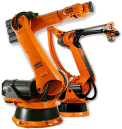 W
WA domestic robot is a type of service robot, an autonomous robot that is primarily used for household chores, but may also be used for education, entertainment or therapy. Thus far, there are only a few limited models, though speculators, such as Bill Gates, have suggested that they could become more common in the future. While most domestic robots are simplistic, some are connected to WiFi home networks or smart environments and are autonomous to a high degree. There were an estimated 16.3 million service robots in 2018.
 W
WA robotic lawn mower is an autonomous robot used to cut lawn grass. A typical robotic lawn mower requires the user to set up a border wire around the lawn that defines the area to be mowed. The robot uses this wire to locate the boundary of the area to be trimmed and in some cases to locate a recharging dock. Robotic mowers are capable of maintaining up to 30,000 m2 (320,000 sq ft) of grass.
 W
WAn automated pool cleaner is a vacuum cleaner that is designed to collect debris and sediment from swimming pools with minimal human intervention.
 W
WpicaBot is a domestic robotic floor cleaner that sweeps, vacuums, and disinfects floors simultaneously.
 W
WRobomow is a manufacturer of robotic lawn mowers. Founded in Even Yehuda, Israel in 1995 by Udi Peless and Shai Abramson, the company provides robotic lawnmowers to the United States and Europe, with prices ranging from hundreds to thousands of dollars/Euros. Robomow mowers are rechargeable, environmentally-friendly designed to meet all safety standards. Robomow also comes with its own mobile application for remote and interactive control. The company has been mentioned in several magazines including: Design News, Business Wire, Washington Home and Garden and Vanity Fair. In May 2017, MTD Products Inc announced their intent to purchase Friendly Robotics. In July 2017, MTD Products announced the completion of the purchase of Robomow.
 W
WA robotic vacuum cleaner, often called a roomba as a generic trademark, is an autonomous robotic vacuum cleaner which has intelligent programming and a limited vacuum floor cleaning system. The original design included manual operation via remote control and a "self-drive" mode which allowed the machine to clean autonomously without human control. Some designs use spinning brushes to reach tight corners, and some include a number of cleaning features along with the vacuuming feature.
 W
WScooba was a floor-scrubbing robot made by iRobot. It was released in limited numbers in December 2005 for the Christmas season, with full production starting in early 2006. The company introduced a lower-priced version, the Scooba 5800, in the second half of 2006. It introduced a new Scooba 450 at CES 2014 in January 2014.
 W
WThe Toyota Partner Robots are a series of humanoid robots developed by Toyota. They debuted playing music on drums and trumpets at the 2005 World EXPO in Aichi, Japan. There are 5 robots in all, most of which have different movement systems. The 5 robots are: Version 1, Version 2, Version 3, Version 4 and the i-Foot . In July 2009, Toyota released a video of the running and standing skills of their partner robot. The robot reaches 7 km/hour, however walking and running can only be achieved on flat surfaces. In 2017, Toyota released its third-generation of humanoid robots, T-HR3, which will be used in space travel.
 W
WWakamaru is a Japanese robot made by Mitsubishi Heavy Industries that is intended to perform natural communication with human beings. The yellow, 3-foot domestic robot debuted in 2005 at a $14,300-$15,000 USD price-point exclusively for Japanese households. Through its development, the Wakamaru has been used for presenting at exhibitions, guiding customers, and working as a desk receptionist. However, the Wakamaru has not advanced beyond its first model that was released in 2005.